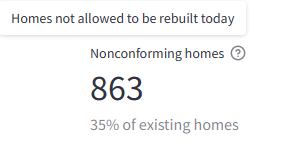The Roslindale map shows that 67% of parcels are nonconforming today, but only 35% of existing homes are nonconforming.
Can you explain this?
The Roslindale map shows that 67% of parcels are nonconforming today, but only 35% of existing homes are nonconforming.
Can you explain this?
Great question! “Nonconforming homes” refers to the number of homes that already exist but exceed capacity constraints set by zoning. As a result, they would not be allowed to be rebuilt today without a zoning variance from the ZBA.

Say there’s a 3-family home built before single-family zoning was implemented. Now that parcel is non-conforming because it exceeds the capacity limitation with 2 non-conforming homes.
In addition to exceeding capacity constraints, a parcel can be considered non-conforming for a number of reasons. In the tool, the other type of non-conformance that is calculated is when the ratio of the building square footage to the lot size exceeds the maximum Floor Area Ratio (FAR) defined in zoning.
Sorry, but I’m still not understanding how the nonconformance rate for parcels is 30% higher than for homes? I’m sure it’s some basic math step that I’m missing?
All good–I agree it’s a bit confusing. Despite the similarly-named metric, they measure different (but related) things.
This is how they are calculated:
Parcel non-conformance rate = ([# of parcels that exceed allowed floor area] + [# parcels that exceed capacity allowance] + [# parcels that exceed both]) / [# total parcels]
Percentage of non-conforming homes = ([# existing homes on parcels that exceed capacity allowance] - [# of homes allowed by zoning]) / [# total homes]
To illustrate the metrics, say we have the following 5,000 sq ft parcels in a single family zone with an allowed FAR of 0.5
Only parcel #3 is conforming with zoning. As a result, the parcel non-conformance rate is 2 non-conforming out of 3 total, so 66%.
Each parcel allows only for a single home and parcel 2 has 1 excess home. Hence, the 1 out of 4 homes or 25% would require a zoning variance to be rebuilt. Parcel 1 would require an FAR variance, but not a capacity one.